// naal : [sanskrit] Umbilical Cord: a connecting element between humans and surroundings and going back to the roots in order to learn from the traditional architecture and adapting the architectural practice back to it.
|| “Humans : a component of the ecosystem?” ||
For thousands of years, man seeked shelter under trees or in caves, always adapting to different settings, understanding the surroundings and mending the way of living so as to get. accustomed to the setting. Nature has always been a significant factor in human survival as man coexisted with it, and also has been dependent on nature for food, housing, and clothes.
Unfortunately, after the industrial revolution in the early 1700’s, a spate of urbanization began, the cities where industries happened, became city centers thus attracting more and more people, which further increased the load on the city fabric. Whereas, The architecture in the pre-industrial era was context specific, it conjointly adhered to the natural resources available, climate of the region, the physical significance of the site, such as: Hydrology, geology, geography, topography, ecosystem around etc. It respected and responded to the cultural, historical, ecological significance; thus, traditional architecture has evolved over generations. [ Industrial Amnesia ]
The research thus focuses on finding alternatives to the (contemporary) conventional methods of construction, and “re-focussing on” or “re-aligning” architecture back to nature and context and paying more attention to the needs of nature and humans rather than marginalizing them over profit. The Genesis of the topic lies in the arguments, observations, and opinions pertinent to the current architectural methodologies, usage of materials, and the need to blatantly follow the trend of Universal or Global Architecture and the use of standardized materials.
“Sometimes the local architecture is so beautiful and so apt that I feel it would be foolish and an affront to try and design in any other way.” – Laurie Baker
| Research Question 01 |
How can we rethink the potential of traditional materials and techniques and adapt them to today’s contemporary context, with the knowledge of the past and advancements in the present and bridge the gap? (‘_____To bring back the LOCALE in architecture!’)
Hence, inquiring how indigenous buildings have incrementally adapted to the climate over time and what attributes make them resilient to climate change should be a priority for now and for the near future.
|| Vernacular Architecture ||
Vernacular Architecture is a reflection of time,evolution, necessity, culture and location with the climate responsive approach at its core¹. It varies globally, embodying unique design principles passed down through generations, preserving cultural identity and promoting environmental resilience.
Contextualisation realizes the sensitivity of the site and its cultural and geographical context which includes topography, landscape and climate. The resulting bioclimatic characteristics are well-suited for sustainable development that focus on passive design strategies. Following the ideology of Cradle to cradle: a bio-approach [closely related to vernacular methods] to the design of products and systems that models human industry on nature’s processes, where materials are viewed as nutrients circulating in healthy, safe metabolisms. The adaptation of ‘earth’ into the present day situation, with the know-how of new age technology and making it befitting for the present thus leading to Contemporary Vernacular.
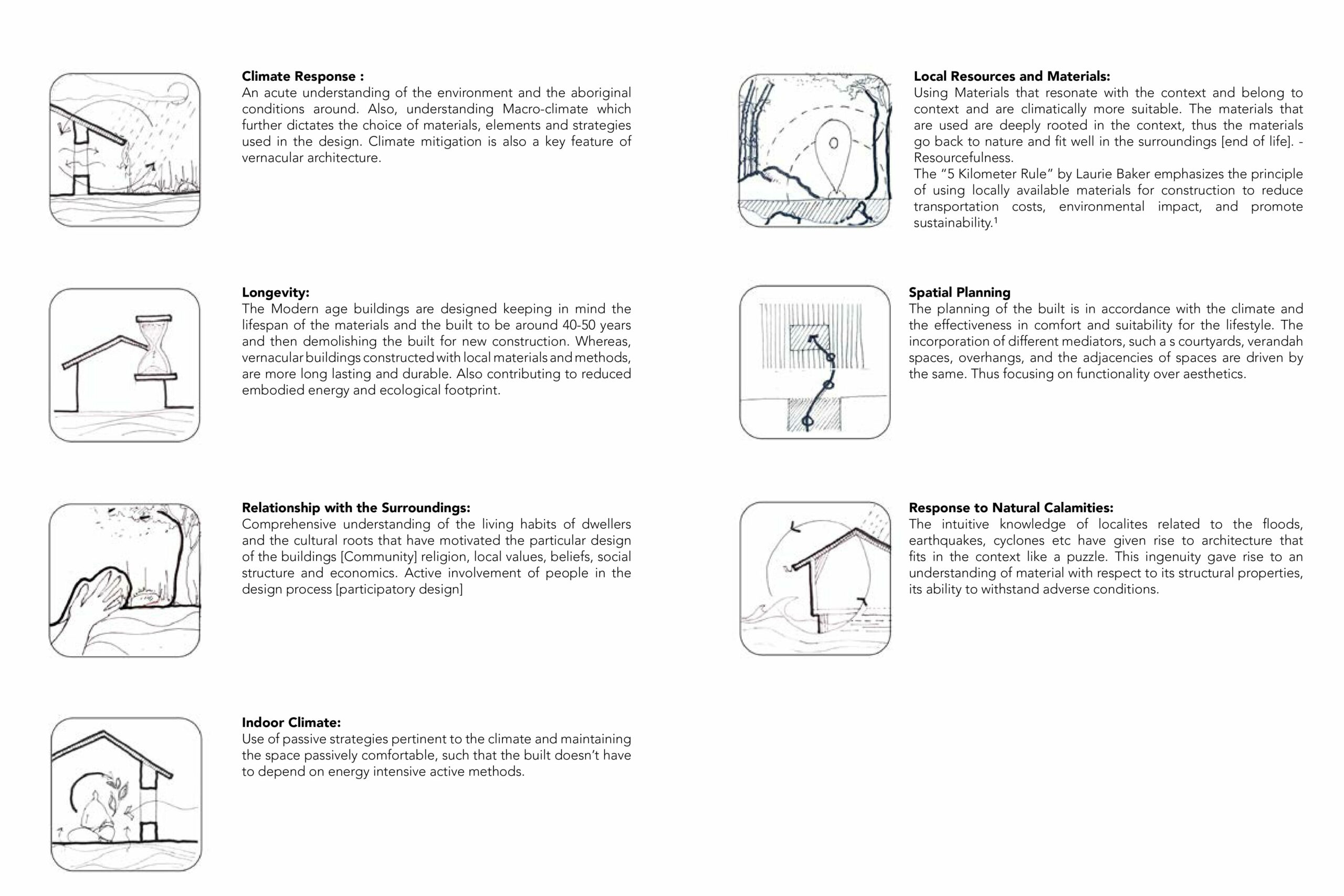
01. Learnings from Vernacular Architecture
|| Objectives ||
To be able to understand and define vernacular and traditional methodologies, materials, and architecture.
Addressing the environmental degradation because of the method of construction and the material used for construction and responding with a design intervention that adheres to the natural habitat, and surroundings, takes cues from the vernacular methodologies, and uses locally available material to create tectonics that resonates with nature for betterment of both; the natural factors and the anthropogenic factors.
Additionally, Understanding the traditional architectural methods and/or materials and re-interpreting them for the present, with the use of new age technologies, and making it appropriate or relevant for present [and future].
| Material-Driven Approach |
The main focus is on adopting one material and extensively studying that material across all climatic zones and understanding how one material is blended in such a diverse climatic region such that there is a promising development in the direction of reviving resourceful management of materials.
|| Earth ||
Earth is the primary material. It is widely available throughout the globe in abundance. Mankind has been tied to Earth since time through different eras of human history. It is one of the most resourceful raw materials to have developed a strong foundation in the world of design and construction. Across the world, indigenous earth construction techniques have been pioneered by many ancient civilizations. Earth/Mud construction does not use up energy as it is easily procured on the plot thus, it will be able to tackle issues such as carbon emission during transportation, manufacturing, etc.

02. Learnings from Material-Driven Approach
Upon understanding the narrative regarding the usage of Earth as a material and also taking a cue from the vernacular/traditional architecture which focuses on the natural calamities and has developed the resilience to the same. Earth as a material has been used in many parts of the world [even in earthquake-prone zones] throughout history and there are Anecdotes addressing this issue. With the advent of newer materials, and technologies, and the lack of knowledge transfer from through the generations; the utilization of the material [mud] in a seismic context is being questioned. There is a societal taboo associated with the use of earth in today’s context and is considered to be a material for the poor. Thus the research addresses the challenges and vulnerabilities of using earth as a construction material in seismic zones while leveraging its strengths for healthier, culturally rich, and sustainable building practices.
__ Incorporating modern engineering practices [present] into traditional earth construction methods and enhancing the resilience of earth buildings in seismic zones.

03. Understanding Earth as a Material
04. Material Distribution: The Map shows the distribution of different materials; (renewable, nonrenewable) throughout the globe.
Source:[Author] Reference: https://github.com/gem/risk-profiles
The observation that the construction industry primarily relies on nonrenewable materials like concrete, steel, and masonry, which pose environmental challenges throughout their lifecycle, highlights a significant sustainability issue. The lifecycle of these materials, typically characterized as “cradle to grave” or “cradle to gate,” encompasses the extraction of raw materials, manufacturing processes, transportation, construction use, and eventual disposal. Each of these stages can have substantial environmental impacts, including high carbon emissions, resource depletion, and waste generation. Conversely, earth architecture, which is more prevalent in regions of the global south or developing regions, presents an alternative that aligns more closely with sustainable and eco-friendly construction practices. The contrast between the sustainability aspects of conventional construction materials and the benefits of earth architecture underlines the need for a global shift towards more sustainable construction practices. This shift can contribute significantly to addressing climate change, resource depletion, and social inequalities, particularly in the context of the global south’s development challenges and opportunities.
| Extent of Earth Architecture |
The extent of earth architecture is significant with approximately 30% of the world living in earthen architecture; out of which 50% is located in Global South¹. This widespread use of this material signifies the versatility, accessibility, and sustainability of the earth as a building material. The techniques used in different regions, encompassing adobe, rammed earth, wattle and daub, compressed earth blocks, etc. This broad adoption of the earth reflects its deep roots in traditional practices and its emerging role in sustainable modern architecture, offering lessons in environmentally responsible construction for the future.
05. Material Distribution: The Map shows the extent of Earth as a material throughout the globe.
Source:[Author] Reference: http://www.earth-auroville.com | http://craterre.org/?new_lang=en_GB
| Climate and Earth Architecture |
The prevalence and techniques of earth architecture are significantly influenced by climate, such that it effectively regulates indoor temperatures, ensuring comfort. For Instance, In arid and semiarid climates, earth [mud] allows thermal mass, which helps to maintain a comfortable interior environment by cooling it during the hot days and retaining warmth during cooler nights. Whereas in more temperate climates, the same material is adapted to manage moisture through overhangs, plasters, or additives that enhance durability against rain and humidity. The extent of earth architecture globally is a testament to its versatility and adaptability.
06. Earth and Climate: The Map shows the extent of Earth as a material throughout the globe overlapped with the climatic conditions to display the vast scope of the material.
Source:[Author] Reference: https://courses.lumenlearning.com/suny-geophysical/chapter/climate-zones-and-biomes/

| Research Question 02 |
How can we comprehensively explore the various facets of “earth,” examining its potential as a construction material, considering the revival of traditional skills, and assessing its adaptability through insights from vernacular traditions, and contemporary advancements? (‘_____To bring back the LOCALE in architecture!’)
|| Natural Calamity: Earthquake ||
Mitigating earthquake risks in architecture involves a comprehensive approach that incorporates advanced engineering principles, innovative design strategies, and adherence to stringent building codes. This multifaceted effort is crucial for urban planning and design, particularly in seismically active regions. The goal is to minimize the destructive impact of seismic events on buildings and infrastructure, ensuring the safety of occupants and the preservation of property. Architects and engineers employ a variety of strategies to enhance the seismic resilience of structures, which can be broadly categorized into material selection, structural design, retrofitting existing buildings, and community planning. Earthquake risk mitigation extends beyond individual buildings to encompass urban planning and community design. Planning for open spaces that can serve as evacuation areas, ensuring clear and accessible escape routes, and developing infrastructure that can withstand seismic forces are crucial components. Zoning regulations can limit construction in areas with high seismic risk or require specific design standards for those areas. Moreover, community education and preparedness programs play a vital role in enhancing resilience to earthquakes.

07. After effects of an Earthquake.
Earth as a material was used in High Seismic Activity areas throughout history. In determining the suitability and resilience of the mud structure, the Seismic Zone, which is characterised by the presence of fault lines where Earth’s tectonic plates meet and move, is crucial. Careful consideration of seismic activity is required in order to guarantee safety and durability during this conventional building method, while at the same time being sustainable and environmentally sound.

08. Earthquake Prone Zones and the Extent of Earth as a material
Source:[Author] Reference: https://www.nsf.gov/news/mmg/mmg_disp.jsp?med_id=64691

| Research Question 03 |
How to adapt the traditional and modern knowledge in earthquake responsive architectural strategies to design solutions for a particular seismic zone with ‘ EARTH’? (‘_____To bring back the LOCALE in architecture!’)
|| Anecdotes ||
The evolution of mud architecture across different regions of the world offers a unique insight into how traditional building techniques have adapted to the challenges posed by seismic activity. By examining case studies from various geographic areas and time periods, we can appreciate the ingenuity and resilience of these structures in the face of natural disasters. These case studies not only highlight the timeline of mud architecture but also testify to the seismic resistance inherent in these construction methods.
These case studies reveal a continuous thread of innovation and adaptation in mud architecture, highlighting its potential to offer sustainable and resilient housing solutions in seismic zones worldwide. The evolution of these techniques, informed by centuries of experience and modern scientific understanding, underscores the enduring relevance of mud architecture in contemporary disaster risk reduction strategies.

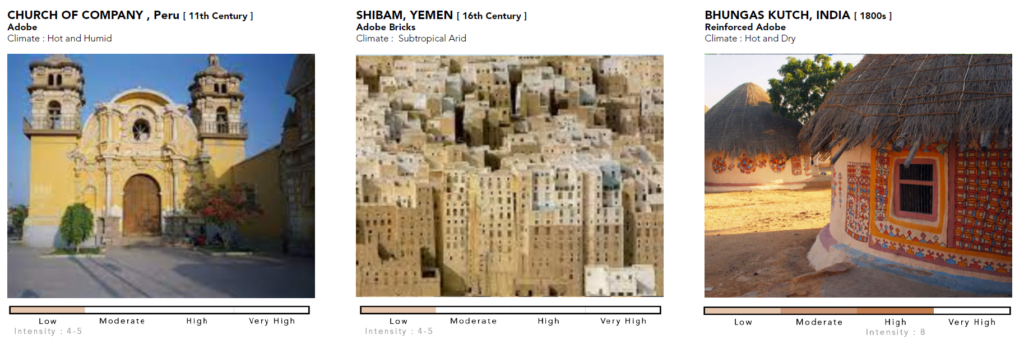

09. Anecdotes of Earth architecture in Earthquake-prone zones and the techniques used.
|| Seismic Considerations ||
The local impacts on a structure depends on the magnitude of the earthquake, but also on the depth and distance from the epicentre, the geology, topography, the kind of local soil and the duration, frequency and acceleration of the impacts. The mitigation of lateral loads during seismic events is a fundamental aspect of earthquake-resistant design. By focusing on reducing resonance, ensuring symmetry, facilitating effective load transfer, and considering the morphology or form of a building, engineers and architects can significantly enhance the seismic resilience of structures. These principles apply broadly across different construction materials and techniques, including traditional and modern building practices.

10. Seismic considerations from the Anecdotes
|| Seismic Considerations of Earth ||
Earth, can exhibit a certain degree of flexibility and ductility; along with the mass and damping effect; which allows the earth to absorb and dissipate seismic energy without suffering catastrophic failure. Earth architecture, which involves the use of earth as a primary building material (e.g., adobe, rammed earth, cob), plays a significant role in seismic zones. Many traditional earth construction techniques exhibit properties such as flexibility, damping, and mass that can contribute to the seismic resistance of structures. Seismic performance varies among different earth construction methods. Proper engineering, construction quality, and adherence to local building codes are crucial to ensure the safety and resilience of earth buildings in seismic-prone areas.

11. Seismic considerations of Earth as a material from the Anecdotes
| Research Question 04 |
“How can “earth” address seismic resistance in architecture, to offer suitable intrinsic properties [the mix] and designing responsive structural systems [techniques]; while drawing inferences from the modern and traditional solutions?
|| Ground Condition and Resonance ||

12. Understanding the Relation between Ground Conditions and The Technique used.
Reference : 1_Minke, G. (2022). Building with earth: Design and technology of a sustainable architecture. Birkha?user.
Down through the ages, people have been using raw earth for building their living spaces. Every single continent, and nearly every country, possesses a rich heritage of earthen buildings. From the roof of the world in Tibet, or the Andes Mountains in Peru, to the Niles shore in Egypt or the fertile valleys of China, many are examples of earth as a building material. There is a use of different techniques throughout different parts of the world and they are applied in different contexts, and with local ingenious.
Considering that the Subsoil condition is a Hard rock, Thus, in theory the technique used should be Light and Flexible.
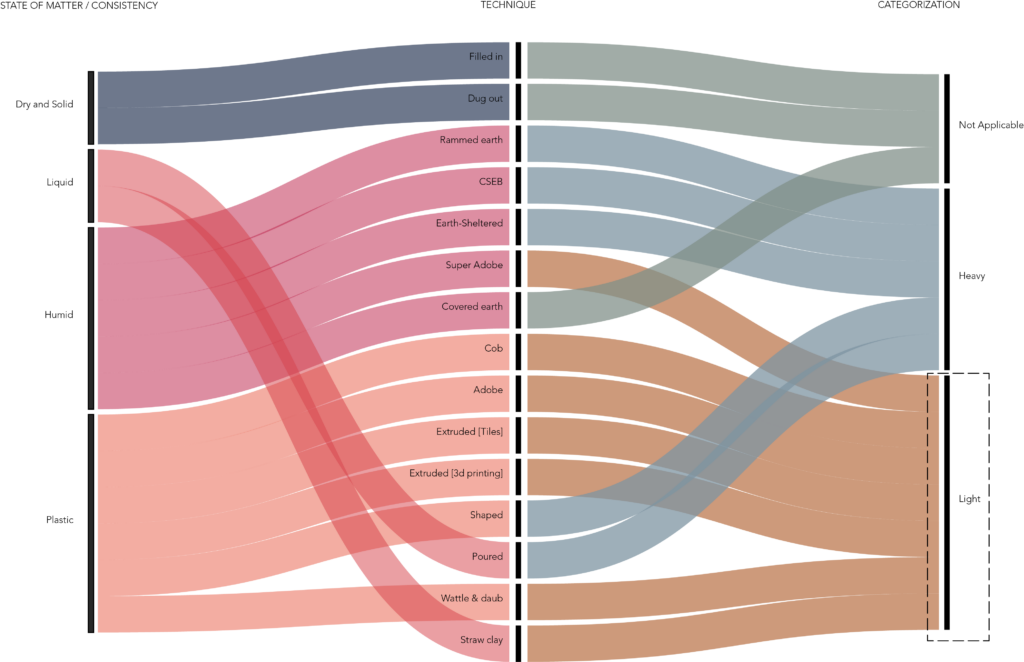
12. Understanding the Relation between Ground Conditions and The Technique used. Source:[Author]
|| Selection of a Technique : Wattle and Daub ||
Wattle and daub is a traditional building technique been used for thousands of years across many parts of the world. The method involves creating a framework or lattice of woven wooden branches or slats or bamboo (wattle), which is then covered with a clay mixture (daub). The daub typically consists of a combination of materials such as clay, earth, sand, straw, and dung, which is applied wet and dried to form a hard, durable surface.
Amongst the Light Techniques available the chosen technique is wattle and daub, as it offers more flexibility and tensigrity from the wooden or bamboo elements, and the compression is catered to by the earth/mud.
This construction technique is simple and uses readily available natural materials, thus providing great thermal properties. Wattle and daub structures are known for their ability to maintain a comfortable indoor temperature, keeping cool in the summer and warm in the winter. Additionally, the flexibility of the wattle allows the structure to be resistant to earthquakes.

13. Wattle and Daub ; Source:[Author]
| The Wattle |
A wattle is a construction technique that dates back through history. It is used for making walls, fences, etc. A consistent weaving of flexible branches, twigs, reeds, thin
timber slats, or bamboo between upright stakes or frames to create a lattice. This lattice is then covered and filled with a mixture of mud, clay, straw, and sometimes animal dung and a few other additives to form a solid wall.
// Studying existing wattles:
Studying existing wattles in structures that utilize the wattle and daub technique delves into traditional building practices, materials used, and the ingenuity of past societies. Research into existing wattles can highlight variations in construction techniques across different regions and periods, reflecting local environmental conditions, available resources, and cultural preferences. For instance, in regions with abundant bamboo, this material might be preferred for its strength and flexibility, whereas in areas with dense forests, split branches or thin trunks of locally available timber species might be used. The two major factors that are crucial for the application of wattle and re-iteration or re-adaptation of the wattle to resist seismic loads.
The Material Selection – The Flexibility, strength, and durability of the wattle come majorly from the material. Typically used materials are wood slats, cane, bamboo, etc.
Consistency- The uniformity in sizing and spacing and adhering to a particular pattern; creating a stable matrix and porosity enough for the daub to grip well.
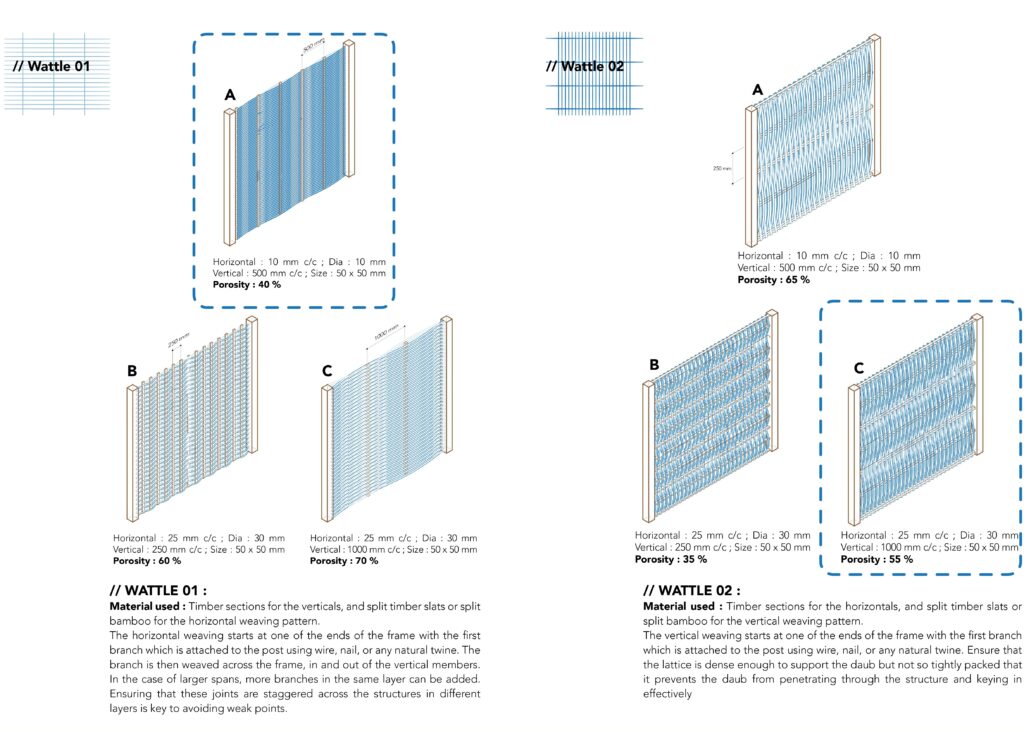
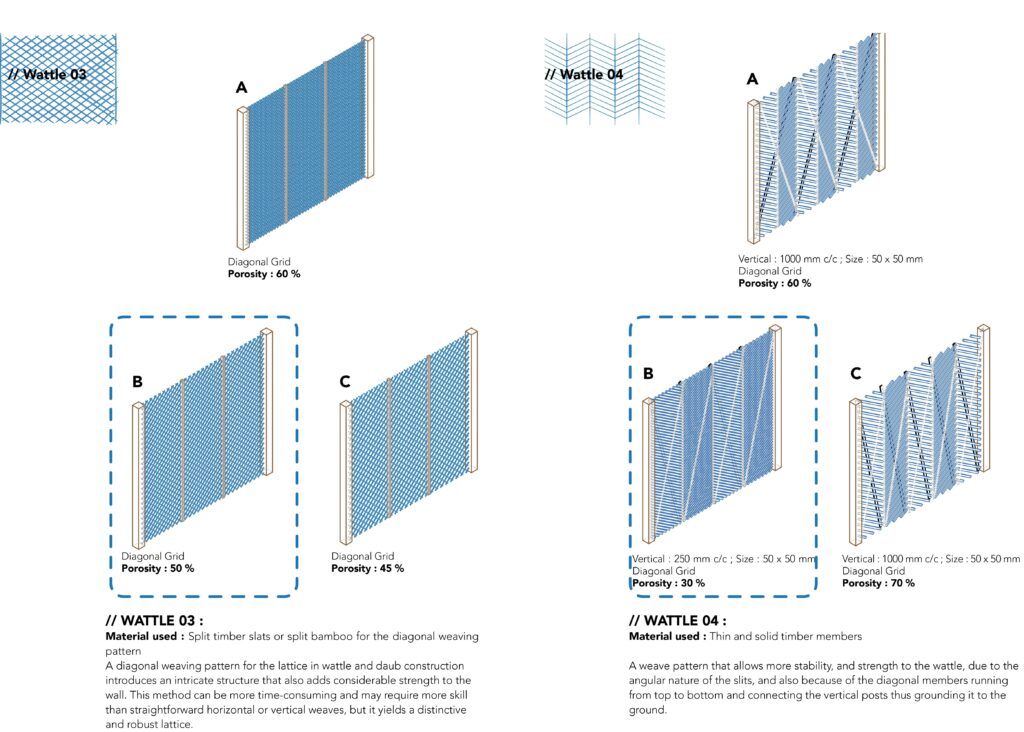
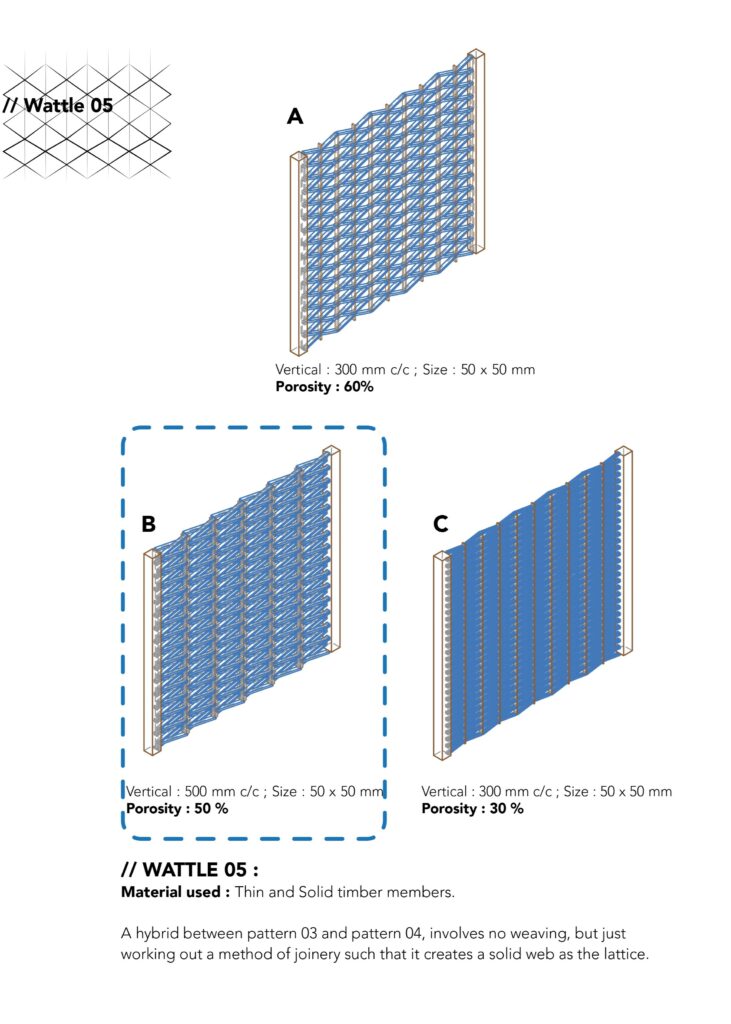
14. Studying the Existing Wattle Patterns
Conclusion:
Weaving Technique: Regular and Consistent
Spacing: 25 – 50 mm; Allows overlap and interweaving to create a network to distribute tensile and shear.
Density: Overly dense weave can be rigid and decrease the ability of the flex and absorb stress. By understanding the existing wattle; it was observed that the POROSITY of the wattle plays a very important role in the structure. The porosity is the factor that allows the daub to sit on both sides, fill the gaps of the wattle, and adhere the whole thing together.
//Re-iterating the Wattle:
Typically the wattle comprises of individual elements, and forms a linear wall element; For tackling seismic activity, the form also plays a very crucial role, thus the wattle can be designed in such a way that it is made into a planar surface [2d surface- ply] to mend it into any form that is seismically sound too.

// Morphology

15. Exploring Morphology
The application of the sine curve form as a buttress in the wattle serves a structural purpose as it allows the wattle then to respond to the lateral loads during seismic activity. Buttresses have traditionally been used to reinforce the walls, in earth, stone, or brick buildings, throughout history. They redirect the lateral forces pushing the wall outward down into the ground. Thus a Sine-curved form buttress introduces dynamism in the wattle makes it more stable, and increases flexibility. Inscribing a Sine curve on the top and bottom edge with different amplitudes such that the bottom curve has more amplitude and the wall takes a buttress form helping with load transfer.
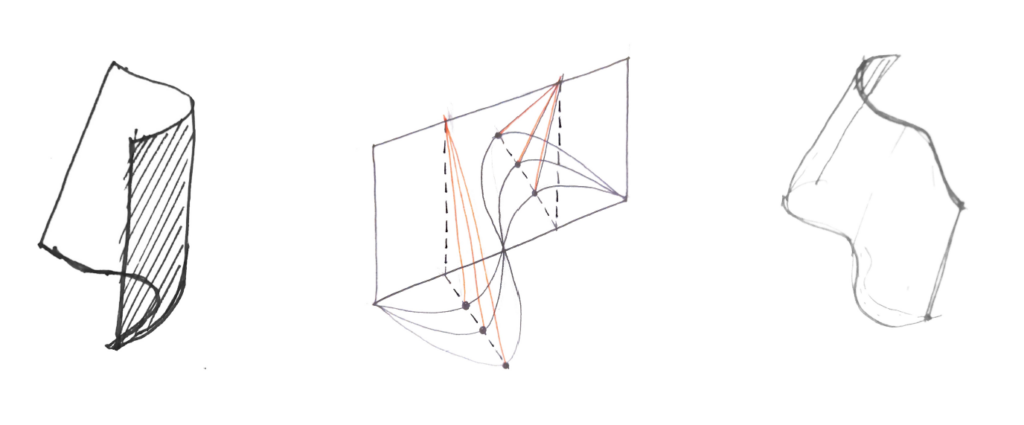
16. Formulating a form such that a buttress-like surface.
// Re-iterated Patterns
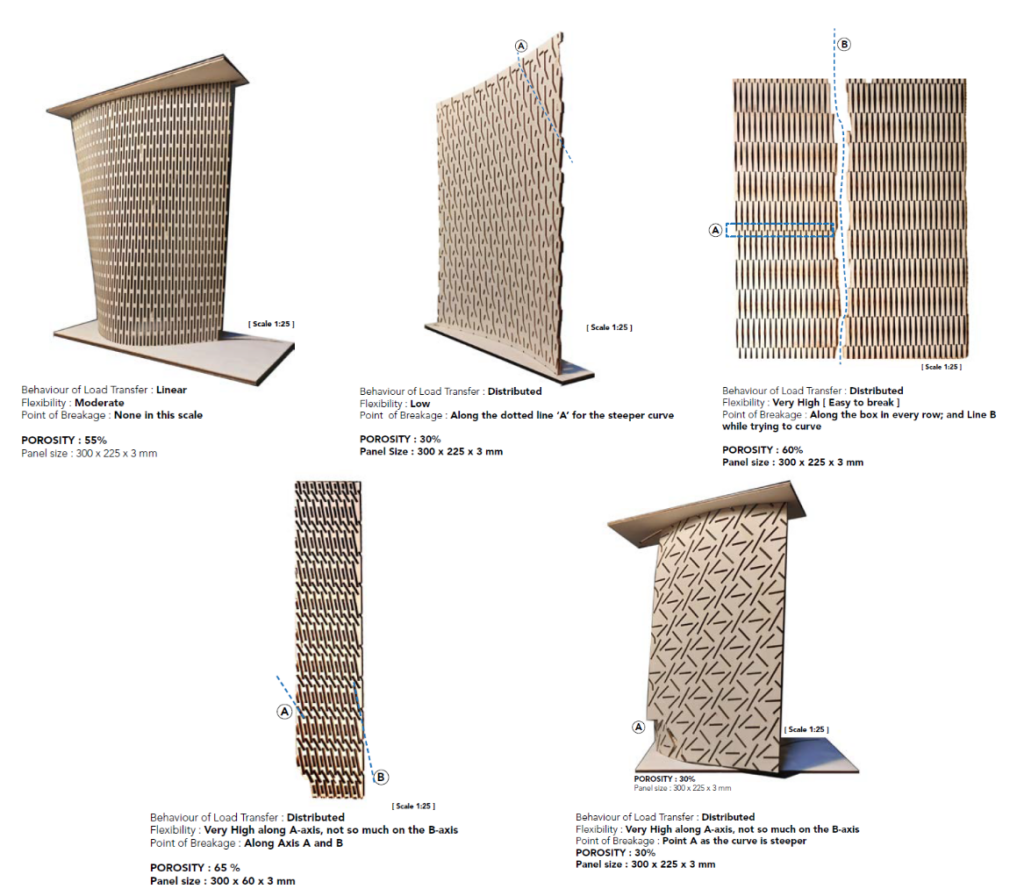
17. Reiterated Wattle Patterns
// Conclusion
a. Pattern 01 works better than the rest of the patterns with respect to porosity and flexibility.
b. In Patterns 02 and 03 the load is getting distributed into smaller loads throughout allowing a more uniform load transfer, instead of it being transferred in one single line from top to bottom as it happens in Pattern 01.
c. Pattern 04 and 05 fail at different locations while obtaining the form and both patterns are less porous than the others, thus providing fewer niches for the daub to fill in.
d. As the porosity increases, the flexibility of the panel also increases, but at the cost of the structural strength.
// Exploring Porosity
To understand the different porosities and sizing and spacing at a 1:1 scale such that the panel has just enough flexibility for the wattle to bend and surface area and niches enough for the Daub to grip.
- The porosity of the Wattle: The porosity of the wattle is crucial because it directly influences the daub’s ability to adhere to the wattle framework. A higher porosity means more surface area for the daub to grip, which increases the bonding strength between the two materials. However, this must be balanced to ensure the wattle’s structural integrity is not compromised. The study of the existing wattles has implied that porosity of about 55-60% is the most efficient with respect to material distribution, adhesion of the daub, and structural integrity of the wattle.
- Sizing and Spacing of the Wattle: The size of the wattle components; in this case, the spacing between the slits and the remaining surface of the plywood plays a pivotal role in achieving the desired balance between flexibility, the structural integrity of the wattle, and surface area for daub adhesion.
a. Horizontal C/C: It determines the distance between every layer of the slit, thus the ratio of solid and void is regulated.
b. Vertical C/C: The length of the slit and the overlapping distance between the slits in consecutive layers is governed by this distance.

18. Exploring Porosity
// Improving Load Distribution:
Improving upon Pattern 01 to achieve a more uniformly distributed load while retaining flexibility, allowing the ply to mend into the desired shape, enhancing structural integrity, and durability, and ensuring effective daub adhesion.
Pattern 01: The Load Transfer in this case is linear thus affecting the load distribution, and it could affect the structural capability of the wattle in real scale.
Pattern 03: To break the linearity, another alternative was to make the slit itself nonlinear, such that the axis is staggered and load flows along that axis. But this pattern fails as it is very fragile and has continous weak points.
a. Step 1 and 2: Amalgamation of Patterns 01 and 03: The first pattern has a linear load distribution; whereas in the other one, the loading axis is staggered and it allows increased distribution of load. Thus, combining the 2 patterns to devise a common geometry that is effectively stronger and breaks the load into smaller components.
b. Step 3 and 4: Smoothening the edges to reduce the failure at the corners: While considering seismic activity and the resultant lateral loads, there is a possibility of failure at the corners and the development of cracks along those axes. Thus, making the slits will have smoother edges.

19. Improving Load Distribution
| Scaling the panel |

19. Improving Load Distribution
// Increasing the efficiency of the panel
Designing a slit pattern in a plywood panel to effectively manage lateral loads, which act perpendicular to the board and typically follow the shortest path to the ground, involves careful consideration of structural dynamics and material behavior.
- Understanding Lateral Loads: Lateral loads, such as wind or seismic forces, can cause bending, shear stress, and potential failure in structural elements. The design must ensure that the plywood panel can resist these forces by effectively transferring the load through the panel to the supporting structure.
- Principles for Designing the Slit Pattern:
a. Orientation: Given that lateral loads will be acting perpendicular to the panel, the orientation of the slits is crucial. Vertical slits could potentially weaken the panel’s ability to resist lateral loads due to reduced cross-sectional area in the direction of the load.
b. Pathways for Load Distribution: Design the slits to create pathways that guide the lateral loads toward the supports in an efficient manner. This could involve strategic angling of slits or creating a pattern that resembles an Arch as it forms a stable structural element in the panel. - Incorporating Flexibility: While the primary goal is to manage lateral loads, some degree of flexibility is beneficial, especially in regions prone to seismic activity where structures need to absorb and dissipate energy without failing.
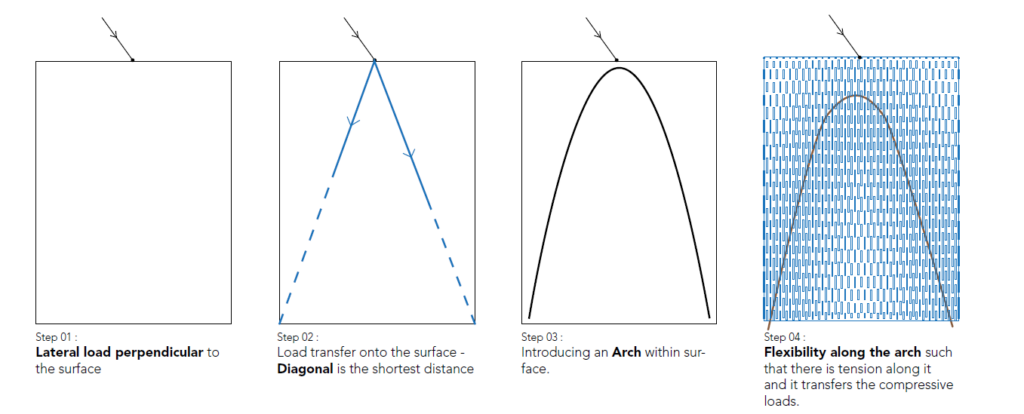
20. Increasing the Efficiency of the Panel
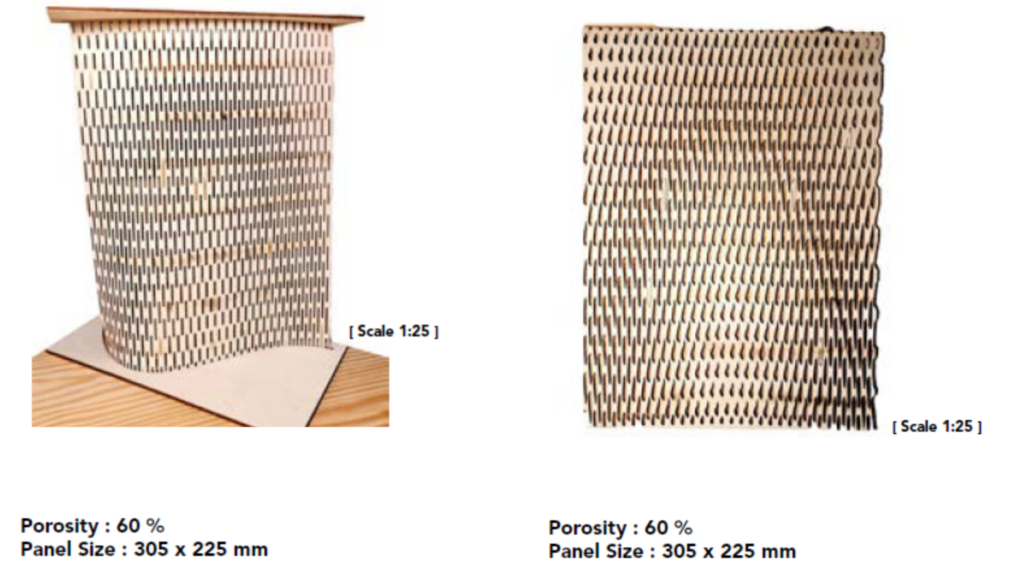
21. Incorporating the Arch in the Panel
| Daub |
The Daub is usually created from a mixture of ingredients from three categories: binders, aggregates and reinforcement. The components [sand, clay, silt, additives, and mediums] are mixed with water to create a thick, pliable mud. The exact proportions can vary based on local conditions and the specific characteristics desired in the finished wall.

22. Components of Soil and The Particle Size
// Intrinsic Properties
The intrinsic properties of earth, especially when considered for use in construction; in techniques like adobe, cob, rammed earth, and wattle and daub etc, encompass a wide range of physical, chemical, and mechanical characteristics. These properties significantly influence the suitability, durability, and interaction with the environment. Changes in the intrinsic properties also affect the Physical, Chemical and Mechanical Properties of the mix.
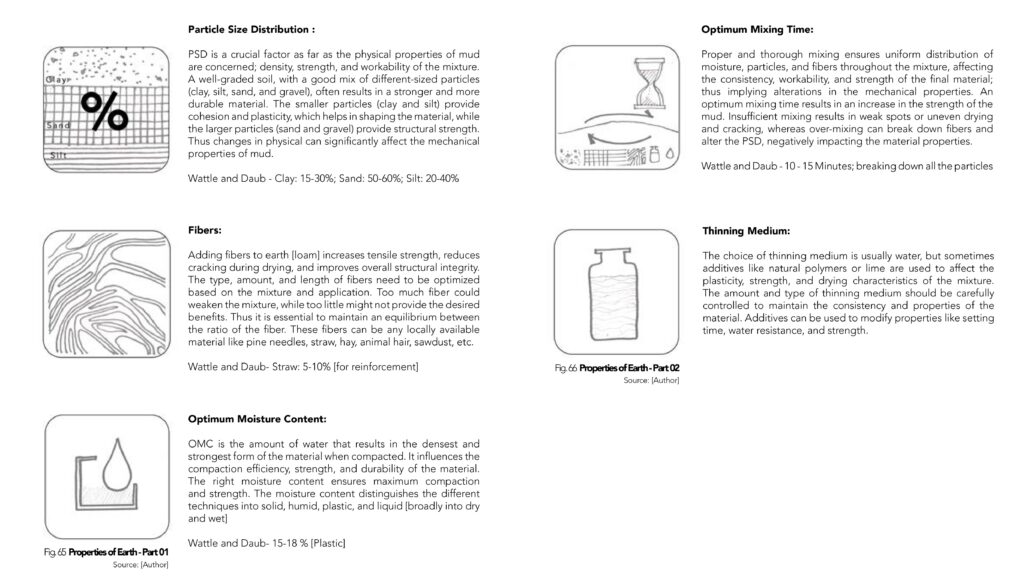
23. Properties of Earth
The intrinsic properties of earth depend on the proportions of the components.
Testing the proportions of a daub mix, to optimize the balance between workability, strength, durability, and drying characteristics. Each mix variation has different ratios of clay, silt, and sand, with constant percentages of hay and water (OMC – Optimum Moisture Content), mixing time, and the wattle layer with a common slit pattern for all three mixes. The proportions of components like clay, silt, sand, and organic matter (e.g., hay or straw) significantly influence the mechanical and physical properties of the daub.

24. Properties affected due to change in proportion : Primary and Secondary
Adjusting the proportions of sand, clay, and silt in a daub mix affects its structural and mechanical properties. The primary properties are as follows:
a. Reduced Shrinkage Cracks: Shrinkage cracks occur as the daub dries and the water content decreases, causing the volume to reduce. Clay and silt significantly contract as they lose moisture, which can lead to cracking, whereas, said does not significantly shrink or swell thus reducing the overall volume change during drying; implying that a daub mix with more sand and less clay and silt will exhibit fewer shrinkage cracks, enhancing the longevity and durability.
b. Increased Compressive Strength: An increased proportion of sand; allows a denser and more stable matrix within the daub and adds to the structural stability and resistance to compaction, thereby increasing the daub’s ability to bear weight and resist deformation under pressure.
c. Enhanced Binding Force: The binding force is the adhesion between the daub components and the daub’s adhesion to the structural framework. While clay and silt provide the primary adhesive qualities due to their fine particle size and plasticity, sand indirectly enhances the binding force by optimizing the distribution and effectiveness of the clay and silt particles, enhancing the overall cohesion and adhesion of the mix.
The secondary properties are affected by the change in proportions of the mix of mud; while achieving an efficient mix for the primary properties. Thus, resistance to erosion and resistance to abrasion are influenced by the material’s surface hardness, cohesion, and ability to withstand external forces such as water flow, wind, and physical contact.
// Exploring Proportions:
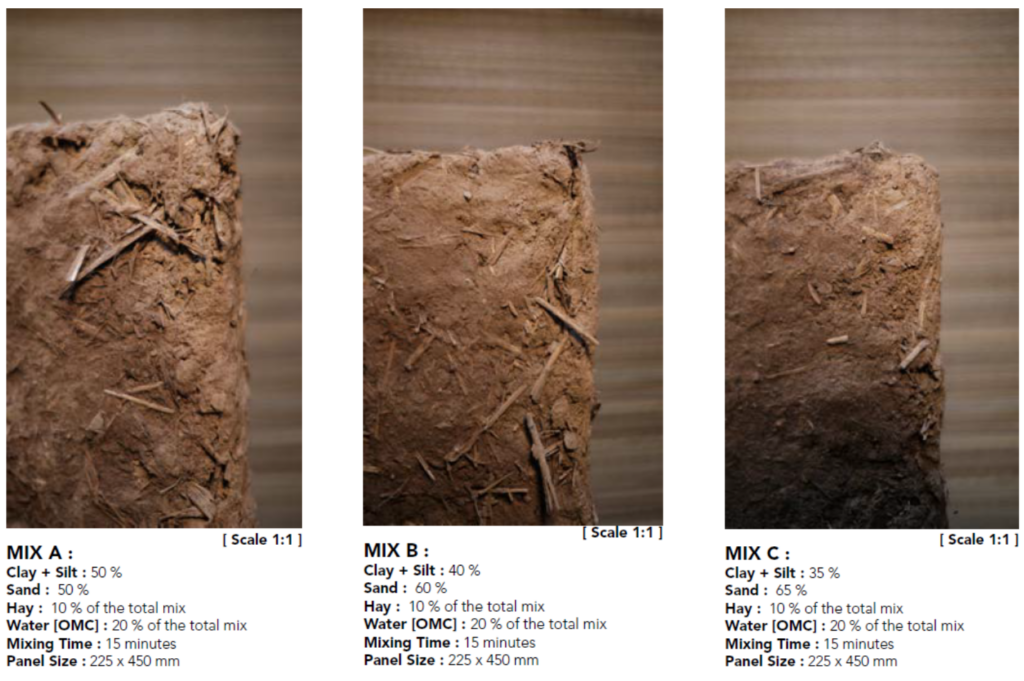
25. Testing Different Proportions
Mix A: The mix has an equal balance of clay+silt and sand; the proportions may offer a good balance between plasticity (from clay and silt) and structural stability (from sand). The relatively high content of clay+silt implies suitability in applications requiring good adhesion and sealing properties.
a. Shrinkage and Cracking: The amount of shrinkage as the daub dries ,may appear be more thus resulting in more pronounced cracks, due to the higher clay content.
b. Structural Strength: This may be the lesser due to the increased clay+silt proportion.
Mix B: Increasing the sand content could improve the structural integrity and reduce shrinkage and cracking upon drying compared to Mix A. This mix might dry to a harder finish, providing good resistance to wear and erosion.
a. Shrinkage and Cracking: The increased sand content effectively reduces shrinkage and cracking.
b. Structural Strength: The higher sand content could increase the strength of this panel.
Mix C: This mix leans heavily towards sand, which could further reduce shrinkage and increase compressive strength.
a. Shrinkage and Cracking: The reduced clay content decreases the shrinkage and cracking of the mix.
b. Structural Strength: The compressive strength and the sand content is directly proportional to the sand content.
| Shake Table |

26. Components of Shake Table
A simple mechanical platform capable of generating vibratory movements to simulate earthquake motions. A platform that can simulate the lateral and vertical movements typical of an earthquake.
Components:
a. Base Frame: Two timber members with L-cross sections form the sturdy sides of the frame, providing vertical support. Two thinner timber sections are attached on top of the L-cross section timbers, completing the rectangular frame. This top layer supports the dowels and the hooks are attached to this frame.
b. Dowels: Placed parallel to each other, these dowels allow the base (which carries the 1:1 panel) to slide back and forth mimicking the seismic movements, thus acting as guide rails.
c. Elastic: Four elastic bands or cords are used, each connected from the hooks on the plywood base to the hooks on the frame. These elastics allow the shaking motion as a result of the necessary tension and resistance, simulating the restraining forces acting on a structure during seismic events.
d. Base: A 350mm x 350mm plywood piece serves as the platform for attaching the 1:1 daub panel mix specimens and is sufficient for individual small-scale testing. This base has hooks at its corners, which align with the hooks on the base frame.
27. Working of the Shake Table
|| Final Prototype ||
The final prototype integrates comprehensive insights gained from studying various daub mixes and the reiterated design of the plywood wattle. It portrays a holistic method to improve the intrinsic properties which has implications on the daub, reiteration of the plywood wattle, and extrinsic properties that focus on enhancing the structural design for increased efficiency and performance.
1. Plywood Wattle Design has a Variable Slit Size and Density, Optimized Slit Orientation, and curving of the edges, that allows a degree of flexibility and load distribution within the panel such that it enables better absorption and distribution of stresses beneficial in seismic-prone areas.
2. Panel Size indicates an application for substantial structural components, possibly for walls or barriers. This size choice suggests the prototype aims to test the scalability of the optimized mix and wattle design in real-world conditions.
3. The Daub mix has a proportion of 65% sand and 35% mixture for Clay and Silt; along with 10% Hay, and an optimum moisture content of 20%. According to the study, this is the most suited mixture with respect to tackling the primary and secondary properties of the mix and thus making it seismically sound too.

28. Final Prototype
|| Further Scope ||

29. Quantitative Analysis and Redesign [left] ; Plywood and Daub sandwich panel [right]
a. Quantitative analysis:
Understanding and analyzing the designed wall quantitatively also and develop more efficient solutions that can be used at different scales with respect to the requirement.
i. Material Properties Testing: Conducting standard tests on the designed wattle and daub panel to measure compressive and tensile strength, thermal conductivity, etc.
ii. Structural Performance: Utilizing software to simulate the wall’s response to lateral loads [majorly seismic as the research focuses on resistance against the same]. This helps in identifying weak points and areas for improvement.
b. Scalability:
To increase the wall thickness for enhanced structural and thermal performance, consider a double plywood system:
i. Plywood-Daub Sandwich Panel: Devising a wall construction method with two plywood wattles with slits sandwiched between three layers of the daub, such that the total thickness of the panel of 12-13 cm is achieved. This system will thus have a thickness suitable for structural walls also, and not only restricting the system to infills or partitions.
ii. Load Distribution: Analysing the load-bearing capacity of this new wall; and understanding any adjustments needed for the daub or the wattle for its sustenance.
_Thank you to all my dear friends who were a part of my journey throughout MAEBB02, by critically approaching the project, and their unwavering support; Nishanth Maheshwaran the best Valldaura teammate, Disha Arora my all-time coffee and food partner, Rujuta Chauhan and her constant support, Aishwarya Balsekar partner in thesis, Basant Abdelrahman , Prati Jain, Santwana Malakar, Sneham Pandey, Nicel Rotta and Indraneel Joshi.

